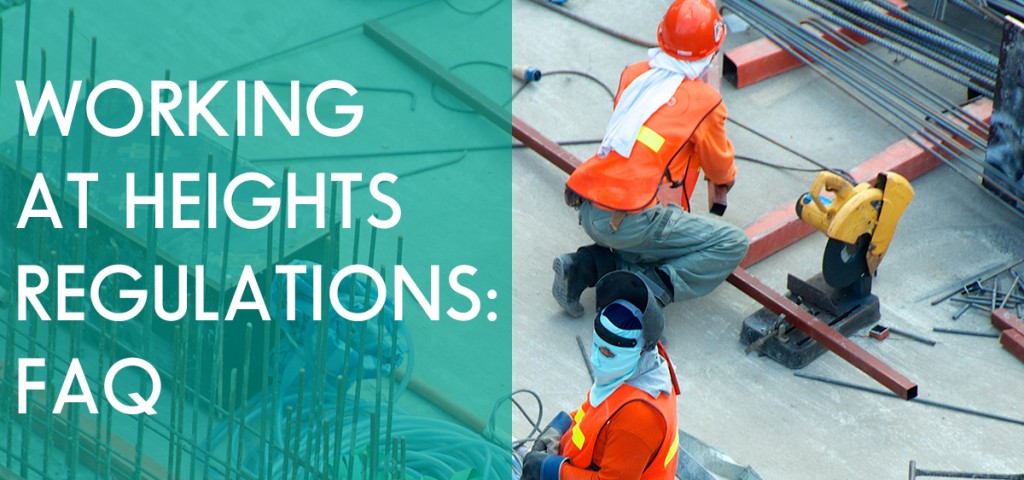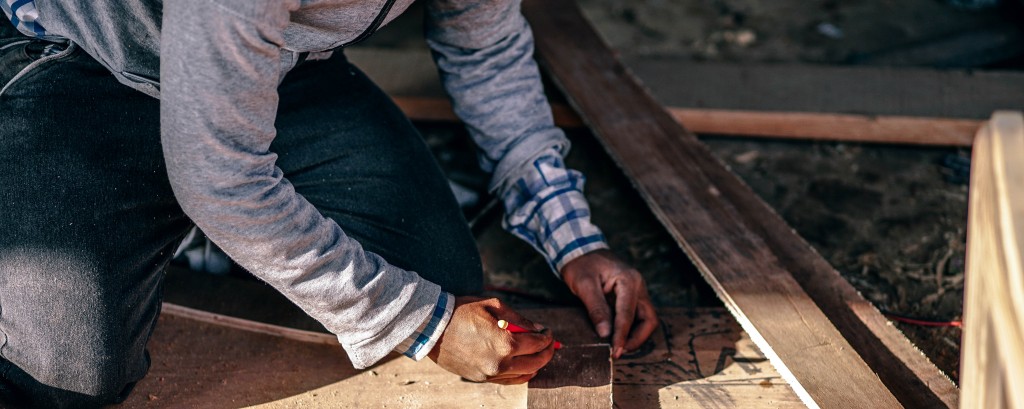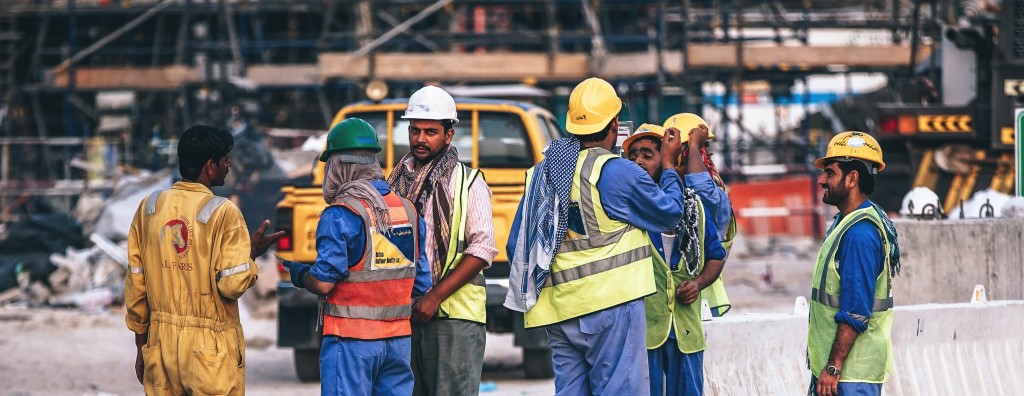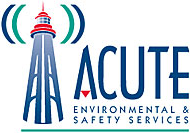
Do you have unanswered questions regarding Working At Heights (WAH) Ontario requirements? This page is here to help you know what you need to work safely at heights. With new Working At Heights legislation and requirements come new questions. If you have more questions or would like information about Working At Heights training, contact ACUTE today!
Looking For Working At Heights Training Now?
Working At Heights Regulations Ontario: Frequently Asked Questions
Check out the following list of frequently asked questions to learn more about Ontario Working At Heights training standards. Still have questions? Didn’t see the answer to your question here? Don’t hesitate to contact ACUTE for more information!

Q: Who needs Working At Heights training?
A: As of 2015, the Ontario Ministry of Labour, Immigration, Training and Skills Development requires training for workers who work on construction projects and use any of the following methods of protection:
- travel restraint systems
- fall restricting systems
- fall arrest systems
- safety nets
- work belts or safety belts
Workers who use any of the above on construction projects MUST receive CPO-approved Working At Heights training before undertaking work at heights (Ontario construction sector plans 2017-2018).
Q: What qualifies as a “fall hazard?”
A: There are many different potential fall hazards when working at heights. A fall hazard is any hazard that may cause someone to fall. Some examples of fall hazards include: missing protective equipment (e.g. guardrails), the misuse of protective equipment, lacking personal protective equipment, poor housekeeping (e.g. failure to clean up a spill), and improper worker training. Click here to learn more.
 Q: When do I have to complete my Working At Heights training by?
Q: When do I have to complete my Working At Heights training by?
A: The original date for completing the new Working At Heights training was April 1st, 2017. However, an extension has been given. Now workers must complete a CPO-approved WAH training course by October 1st, 2017. For more information about these requirements, visit the Ontario Ministry of Labour, Immigration, Training and Skills Development Notices page.
Q: For Construction Projects, what are the recent Occupational Health and Safety Awareness and Training Regulation (OHSA) amendments I should know about?
A: Construction Projects – O. Reg. 242/16, amending O. Reg. 213/91: Amendments have been made strengthening and clarifying the requirements for using suspended access equipment. The amendments came into force on January 1, 2017. Some of these amendments include:
- Requirements for roof plans and other specific work plans
- New training requirements for workers who may use or inspect suspended access equipment
- Enhancement of existing inspection, testing, and maintenance requirements
- For the full list and more information, visit the Ontario General Contractors Association and the MLITSD Notices page.

Q: Who is responsible for ensuring workers complete proper Working At Heights training?
A: It is the employer’s responsibility to ensure that workers complete a CPO-approved Working At Heights training program delivered by a CPO-approved trainer before workers begin work at heights. For more information on Working At Heights responsibilities, visit the MLITSD Working At Heights Training page.
Q: How long is Working At Heights training valid for?
A: Working At Heights training is valid for three years after the completion date. After three years, workers are required to complete a Working At Heights refresher training course.

Q: Is a code of practice necessary when working from an elevating work platform at a height of 7.5 meters or more?
A: Yes. The legislation does require a code of practice when working from an elevating work platform at a height of 7.5 meters or more.
Source: http://travailsecuritairenb.ca/docs/QuestionsandAnswers.pdf
Q: If I want to install permanent guardrails on my roof, what are the legislative requirements?
A: It depends on whether the structure to which the guardrails will be installed will have little public access or general public access. If the structure has little to no public access, then you should follow the guidelines given in section 97 of General Regulation 91-191. If the structure is accessible to the general public, then you must follow the provisions of the Canadian Building Code.
Source: http://travailsecuritairenb.ca/docs/QuestionsandAnswers.pdf

Q: How do workers know if structural building components (for example, the steel beams of HVAC systems) are adequate to be used as anchors in a fall protection system?
A: Since these structural building components were not originally intended to be used as anchors in a fall protection system, there are no supplier instructions on how to determine the adequacy of these systems if used as anchors. Therefore, in order to determine if these components can be used as safe and adequate anchors, workers must rely on the expertise of an engineer or other competent person to determine adequacy. Legislation requires that anchors must be able to withstand 22kN of force, and when used by a competent person, be able to withstand four times the maximum load. Source: http://travailsecuritairenb.ca/docs/QuestionsandAnswers.pdf.
Working At Heights – What to Expect?

If you are about to take your first Working At Heights training course, one of the biggest questions you may have is, “What should I expect?” With ACUTE, our main objectives for Working At Heights training are to strengthen workplace safety culture, provide workers with adequate knowledge about fall hazards and general WAH safety practices, provide workers with sufficient knowledge on fall protection equipment, and reduce the number of fall accidents, injuries, and fatalities. Work with ACUTE today.
The course includes:
- Working At Heights legislation
- Working At Heights hazards
- Safe Work Plans, how to assess and control WAH hazards
- Fall prevention strategies, fall protection equipment
- Classroom interactions with experienced instructors
- Tabletop scenarios, detailed handouts, videos, quizzes, demonstration and hands-on training, and practical performance evaluations
- And much more!
Looking for WAH Safety training?
ACUTE – Helping You Work Safe!
With over 100 years of combined industry experience, you can trust that with ACUTE, you will experience only the best comprehensive, hands-on Working At Heights training. Here are some ways that ACUTE goes beyond government compliance in Ontario health and safety training.
- Open Door Instructor-Student Partnersh
 ip: ACUTE’s training services emphasize client participation. Staff foster relationships with clients and serve as a touchstone for advice moving forward.
ip: ACUTE’s training services emphasize client participation. Staff foster relationships with clients and serve as a touchstone for advice moving forward. - Serving Your Team and Industry: With a vast array of clients in the manufacturing, construction, health, academic, and government sectors, ACUTE brings the best safety practices from across the spectrum to your workplace.
- 100 Years Combined Experience: ACUTE provides comprehensive health and safety training, on-site safety services, and consulting services. With over 100 years of combined experience, our staff offers more than theoretical or abstract ideas. ACUTE offers solutions.
- Track Record of Success: ACUTE is rated 4.9/5 stars on Google reviews, demonstrating a commitment to our clients, quality, and a passion for training.
Contact us today for quality training in your workplace or on-site at ACUTE’s proven training facilities!
“Knowledgeable and professional trainers that understand the practical applications of the material they teach. They were able to give me confidence to go and use my training – exactly what I wanted.”
– Joel – Read more testimonials here

